You
can grow practically every type
of plant in containers - from
flowering and foliage annuals
and perennials to vegetables and
herbs to trees and shrubs.
Container planting is a great
way to add color to your garden,
curb appeal to your home and enjoyment
to your life. It's a versatile
way to liven up your personal
space and have lots of fun doing
it. With pots, you can let your
imagination run wild. There are
endless combinations. And best
of all, you can do it easily and
affordably.
Don't let lack of experience,
space or time put a damper on
this gardening project. All you
need is an hour or two, a suitable
container, some lovely plants,
and a sunny or shady place on
your patio, deck or porch.
If you don't have space for a
vegetable garden, or if your outdoor
space doesn't provide the necessary
elements to produce the flower
garden you've always wanted, consider
the possibility of "container
gardening." A patio, deck,
balcony, or doorstep can provide
enough space for a productive,
attractive display.
If you live in an apartment with
limited outdoor space, you might
consider doing a little indoor
gardening. By using sunny window
sills, you can grow a number of
herbs.
Benefits
of Container Gardening
Convenience
- While space (or lack of it)
is an obvious reason to try container
gardening, that's not the only
reason people choose this method.
Often, convenience plays a big
part, especially for vegetables
and herbs. Having these essentially
at your fingertips is a tremendous
advantage. The mobility of container
gardening makes it easy to rearrange
and resculpture your garden and
to add new elements of interest
and beauty. Container plantings
provide great flexibility and
versatility as well. It's easy
to rotate plants to update the
look of your space and makes it
incredibly simple to care for
them.
Time
- For busy two-worker families
who don't have time to produce
a large garden, a number of well-placed
pots on the deck often can do
the trick. For the elderly who
can't garden anymore, sometimes
a simple tomato plant conveniently
located by the back door may be
enough to satisfy the craving
for fresh vegetables and to recall
memories of days past.
Economy
- Smaller spaces result in smaller
costs. Initial set-up costs may
be a little more, but once the
appropriate containers and materials
are purchased, costs are minimal.
You will be buy fewer plants,
less media, and less fertilizer
than for traditional gardening.
Display
- Just as a garden can be a work
of art, a well-planned container
garden can too. Carefully selecting
plants will result in a beautiful,
yet functional, display with function.
What
you'll need to get started:

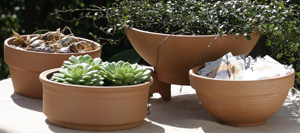
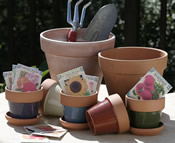

|
Appropriate
Containers - The
first step in planning your
container garden is to decide
on a container. Just about
anything that can hold soil
and offers drainage qualifies.
All containers, whether
clay, wood, plastic, or
ceramic, should have an
adequate number of holes
in the bottom for proper
drainage. (Unless you are
looking to do a container
water garden
or fountain where a
water-tight container is
preferable.) Additional
holes should be drilled
or punched in containers
that do not drain quickly
after each watering. Gravel
or rocks can also be placed
in the bottom of larger
containers to sevre as a
reservoir. Setting the container
on a solid surface, such
as a cement or patio floor,
reduces drainage. Raising
the container one or two
inches off the floor by
setting it on blocks of
wood or clay feet will solve
this problem.
The container's size will
be determined by the plant(s)
select, so select your plants
first. Generally, most plants
grown in the soil can be
grown in containers as long
as ample space is provided
for them to develop roots.
Most all plants you will
find at the nursery can
be grown in pots and containers,
however, some prefer growing
in the ground. Shallow-rooted
plants like many annuals
and perennials, lettuce,
peppers, radishes, and herbs
need a container at least
6 inches in diameter with
an 8-inch soil depth. Bushel
baskets, half barrels, wooden
tubs, or large pressed paper
containers are ideal for
growing tomatoes, squash,
pole beans, cucumbers, and
deep-rooted perennials and
shrubs. |
Planting
Media - A fairly
lightweight mix that holds water
more evenly is best for container
gardening. We offer Pennington
Professinal Potting Soil at the
nursery. Sometimes, when planting
ornamentals in containers, we'll
mix in a little cheap grade potting
soil to heavy the mix. Soil straight
from the garden usually cannot
be used in a container because
it's too heavy. Clay soil holds
too much moisture when wet, resulting
in too little air for the roots.
Also, it pulls away from the sides
of the pot when dry. Container
medium must be porous in order
to support plants, because roots
require both air and water.
Fertilizer
- We usually fertilize
container plants with a water-soluble
fertilzer such as MiracleGro however
for ornamental shrubs we use a
granular shub and tree fertilizer.
Always refer to instructions on
package for rates of application.
An occasional application of fish
emulsion or compost, such as mushroom
compost or composted cow manure
will add trace elements, vital
nutrients and organisms to the
soil. Do not add more than the
recommended rate of any fertilizer.
Doing so may cause fertilizer
burn and kill your plants. Unlike
garden plants, container plants
do not have the buffer of large
volumes of soil and humus to protect
them from over-fertilizing.
Water
Requirements - Pay
particular attention to watering
container plants. Because the
volume of soil is relatively small,
containers can dry out quickly
during the hotter summer months,
especially if they are on a concrete
patio in full sunlight. Daily
or twice-daily watering may be
necessary. Apply water until it
runs out the drainage holes.
Clay pots and other porous containers
may need water more frequently,
as they allow additional evaporation
from the sides of the pots. Small
pots also tend to dry out more
quickly than larger ones. If the
soil appears to be getting excessively
dry (plants wilting every day
is one sign), group the containers
together so that the foliage creates
a canopy to help shade the soil
and keep it cool. You may also
add a light layer of mulch to
help slow evaporation.
The best way to check to see
if a container needs water is
the finger test - feel the soil
to determine whether it is damp.
Light
Requirements -
The amount of sunlight your container
garden spot receives may determine
which crops can be grown. Check
light requirements for specific
plants. Gain access on our site
to listings for all the various
annuals, perennials, herbs, and
more in the Garden
Center.
Plant
Material - Plant
breeders have helped to make container
gardening more practical by breeding
plants having compact growth habits.
Almost any vegetable, annual
or perennial
plant, and many spring
bulbs and summer
bulbs can be adapted to container
culture. The possibilities are
endless.
 |
Vegetables
Here is a listing of vegetables
great for growing in containers:
Beans / Bush Beets / Carrots
/ Cabbage / Cucumbers /
Eggplant / Kale / Lettuce
/ Leaf Mustard Greens /
Onions / Peppers / Squash
/ Tomatoes / Turnips |
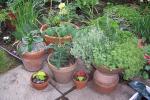
|
Herbs
| Annual
Herbs:
Anise / Basil
/ Chervil / Coriander
/ Dill / Summer Savory |
| Biennial
Herbs:
Caraway / Parsley |
| Perennial
Herbs:
Chives /Fennel / Lavender
/ Lovage / Marjoram
/ Mints / Rosemary /
Sages / Tarragon / Thyme
/ Winter Savory |
|
Herbs
Available at Wilson Bros. Nursery
in Spring and Summer
 |
Fruits
Here
are some fruits suitable
for planting in containers:
Strawberries / Blueberries
/ Raspberries / Blackberries
|
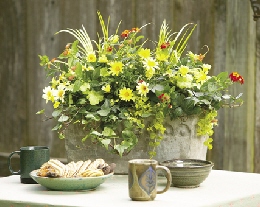 |
Annual
Plants in
containers
are
great for use on decks, patios,
porches, around pools, and
just about anywhere you can
think of. |
Container
Combination Ideas Using Annuals
l Annuals
for Sun
I Annuals
for Shade
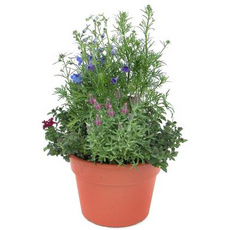 |
Perennials
Plants are
great for use on decks, patios,
porches, around pools, in
the perennial garden or just
about anywhere you can think
of to use them. |
Perennial
Home Page I
Perennials
for Sun I
Perennials
for Shade I
Perennials
For Butterflies I
Perennials
for Hummingbirds I
Perennials
for Fragrance
____________________________________________________________________
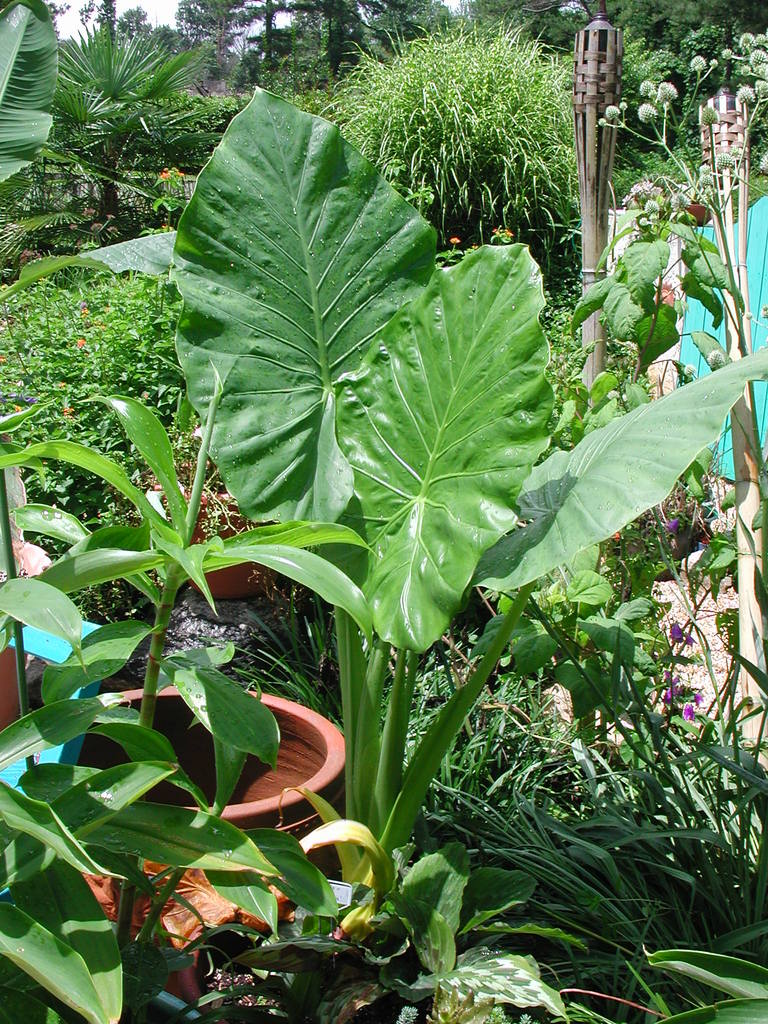 |
Exotic
Foliage / Tropical Plants
This
group of plants is excellent
for use on decks, patios,
around pools or jacuzzi's,
near sitting areas, and
around ponds.
Alamanda / Banana Trees
/ Caladiums / Canna Lilies
/ Elephant Ears / Hibiscus
- Tropical or Hardy / Mandevilla
/ Palms / Yuccas |
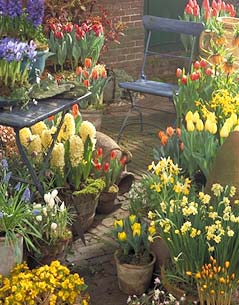 |
Bulbs
you can force
many spring bulbs in containers
for indoor use. Plant summer
bulbs in containers to be
placed on decks, patios,
porches or whever else you
might enjoy them.
All
ABout Summer Bulbs I
All
About Spring Bulbs |

|
Trees
When planting
trees in pots, you obviously
have to proportion the tree
to the pot. You definitely
don’t want to try
to grow some gigantic oak
tree in a pot, but there
are a variety of trees that
will work quite well in
containers.
Japanese Maples / Crape
Myrtles / Tree Form Hollies
/ Tree
Home Page |
Planting
in Containers
Plants
- Plant container plants at the
same time you would plant them
in a regular garden or flower
bed. Go to Planting
In Containers for
basic step-by-step guidelines.
Seed
- Sow seeds according to instructions
on the seed package or plant tag.
After planting seeds, gently soak
the soil with water, being careful
not to wash out or displace seeds
that have been planted. When seedlings
have sprouted to two or three
leaves thin then out if necessary
to obtain proper spacing. If cages,
stakes, or other supports are
needed, provide them when the
plants are very small to avoid
later root or branch damage.
In
Summary
Container gardening gives you
endless possibilities for beautifying
your home–inside and out.
While many people focus strictly
on pots for indoor use, there
are many creative ideas for outside
use as well. Open your mind to
new unique ideas...your own ideas,
and you’ll soon discover
that with pottery and contaniner
gardening, you are only limited
by your imagination!
FAQ's
about
container planting
Q: Can my clay
or concrete planters be left outdoors
for the winter?
A: Yes, but these
types of containers absorb moisture
and if it freezes, expansion may
cause them to crack.
Q: Can my planters
be painted?
A: Yes. Before
painting clay pots, use Pennington's
Clay Pot Sealer. Choose a paint
used for porous surfaces. Craft
stores will most likely carry
this type of paint.
Q: What determines
the size of a planter? How do
you measure this size?
A: General consensus
is the right inside lip to the
left outside lip, although this
too may vary by manufacturer.
Q: What size
saucer should I use for my planter?
A: The saucer
should be equal to the top diameter
of the planter. This ensures a
proper reservoir.
Q: How do I clean
my conatiners?
A: Use a solution
of vinegar and water.
Q: How do I use
a clay planter that does not have
a drain hole in it?
A: Use the planter
as a decorative dressing for your
pre-potted plant, or you may fill
the bottom of the planter with
pea pebbles or gravel, and then
add a medium that drains well
- or you could choose to use it
for making a container
water or bog garden.
Another possibility is to use
a small drill bit to drill a hole
in the planter; however you should
use caution when doing this as
some planters may not withstand
the drilling.
Q: How can I
tell if my planters have enough
water in the soil?
A: There is a
slight change in the color of
terra cotta planters when the
soil inside the planter is moist.
Over time, you will be able to
tell these differences and know
exactly when your plant needs
additional water. For other types
of planters use the finger test
to check for soil moiture.
Q: I have a very
big planter that is hard for me
to move inside during the winter
months. What can I do to make
this move easier on me?
A: You can do
several things that will make
this planter easier to move. You
may fill the bottom of the planter
with a Styrofoam square that will
take the place of unnecessary
compacted soil. This will make
the pot lighter and easier to
move. You may also put the planter
on a plant dolly. These plant
dollies can be found alongside
planters in most retail environments.
|